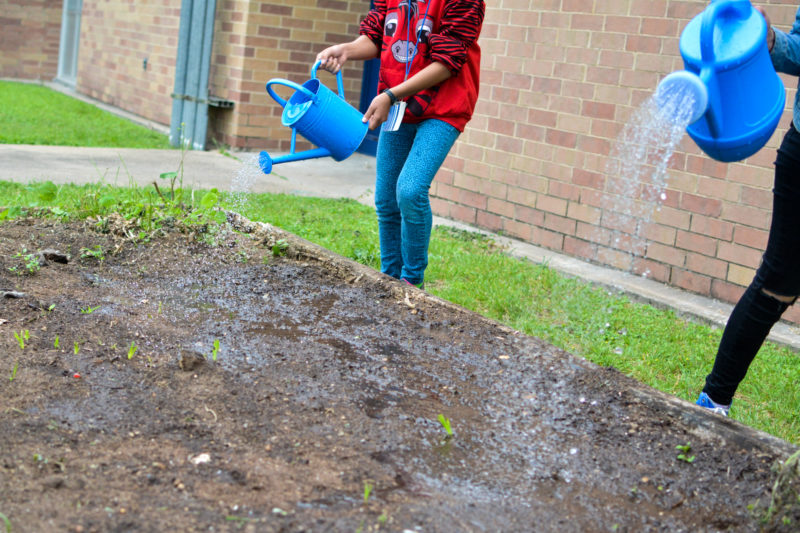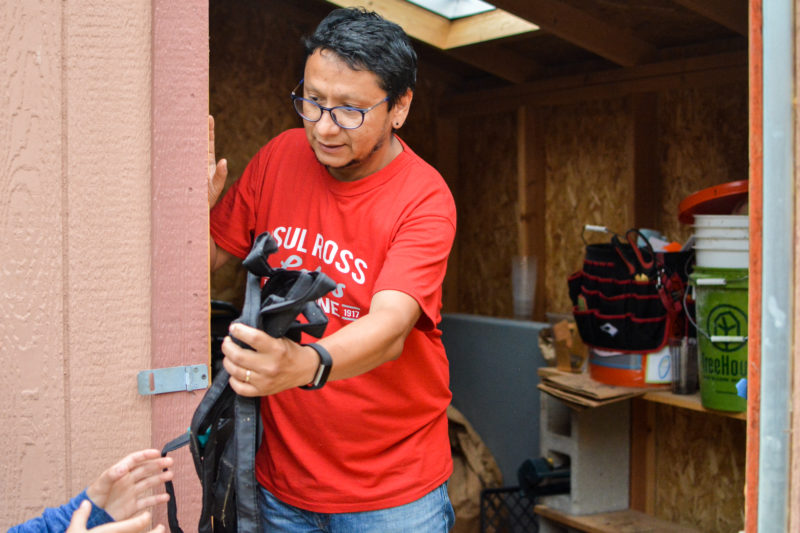At an Austin Elementary School, Refugees Represent 22 Nationalities
By Kathryn Lundstrom
Reporting Texas

Juan Yniguez walks to the school garden with his class of refugee children at Wooldridge Elementary in Austin. Ashley Ephraim/ Reporting Texas.
Lynn Conroy taught her first refugee student in the early 1990s, a boy named Ado from Bosnia who didn’t speak a word of English. Conroy already had teaching experience in a Texas border town and had gone back to school for her ESL certification. But when Ado walked in, the challenge and rewards of teaching refugees became her passion.
Two and a half decades later, Conroy works exclusively with “newcomers” — kids who have just arrived as refugees and immigrants, usually with little to no English skills. She is one of the teachers and administrators in a dual-language learning program at north Austin’s Wooldridge Elementary School. The 607 students represent 22 nationalities.
The program’s goal is to support English language learners while ensuring that the value of their first language isn’t lost. Conroy and others on the teaching team know the statistics: Children learning English during school have a graduation rate of just above 60 percent nationally, compared with around 80 percent for the general population, according to the Migration Policy Institute.
For refugee kids, many of whom spent years living in refugee camps and without consistent access to education, graduation rates are even lower.
The staff at Wooldridge, where about 10 percent of the student population arrived as refugees, hopes to challenge those odds. “Bilingual education is the way to go,” Conroy says, stressing the importance of incorporating the students’ native languages to whatever extent possible while providing extra English-language support.
“It’s such a rewarding job because you get to see people who are so motivated to learn. We have the privilege of watching that blossom.”
Rebecca Callahan studies bilingual education at the University of Texas at Austin. Her findings support a strategy that reinforces and builds on a student’s primary language while learning English.
“That primary language is actually an incredible resource,” Callahan says. “Bilinguals have cognitive and labor market advantages. The better outcomes of these kids coming out of school, the better off we are as a society.”
Still, it’s hard for schools to provide language support for such a diverse population, particularly given the large numbers at Wooldridge. Refugees are estimated to account for between 1 and 5 percent of the student population in U.S. schools overall, according to Callahan.

Refugee students at Wooldridge spend their morning tending to the garden on the school campus. Ashley Ephraim/ Reporting Texas
Refugee kids require extra psychological support services after the trauma of fleeing violence. “There’s this extra layer where refugee students have often seen war and bloodshed,” Callahan says. “These are things that you and I haven’t seen in a horror film.”
Ban al-Baghdadi, 42, a native of Iraq, came to the U.S. in 2013. She now assists the nearly 700 Arabic-speaking students and their families in the Austin Independent School District. “Wooldridge does so much for refugees,” she says.
As the district’s refugee family support coordinator, al-Baghdadi works with newly arrived parents to register their children for school, assisting with paperwork and administrative hurdles as well as serving as a cultural guide for families settling into their new communities. Getting to and from school can be difficult for families when they first arrive without a car, especially when the age range spans multiple schools.
“A lot of people use the bus, but those who came from overseas, it’s hard for them to let their kids walk alone on the street,” al-Baghdadi says.
On a normal day in the newcomers’ classroom, Conroy and teacher Juan Yñiguez spend a lot of time just practicing vocabulary and allowing the kids to get comfortable with the rhythm of life in the U.S. The children tend a garden in the schoolyard, learn songs and dances, play number games and practice days of the week together. The kids spend only part of the week in the newcomers’ class and transition to the regular classroom full-time when they have the English skills to keep up.
Two recent arrivals from Syria, sisters ages 8 and 12, recently joined the class after spending years in refugee camps waiting for the United Nations lottery system to assign them a new home. Both girls face uphill battles starting school. Because of the way the curriculum becomes more writing-based after second grade, it is tough for older students to focus on the language and keep up with their schoolwork at the same time, Yñiguez says.

Juan Yñiguez hands his students the hose so they can water the garden. Ashley Ephraim/ Reporting Texas
At 12, the older of the two is already past the age where language acquisition comes relatively easily. At this point, she mainly relies on her Iraqi classmates to translate the teacher’s instructions for her. The younger sister has special needs and requires one-on-one supervision while at school.
Yñiguez, 43, is “a master at getting kids to come out of their shells,” Conroy says. An immigrant from Mexico, Yñiguez says that as a child, he was beaten in school in South Texas for speaking his native Spanish. In his classroom, Yñiguez wants to send the opposite message: “Their language is just as viable as ours, with just as much history.”
Most of the newcomers these days are from Iraq, Afghanistan and Syria, al-Baghdadi says, although the current class also has students from Rwanda and Thailand. But the numbers have slowed since President Donald Trump began limiting immigration from the Middle East. The district now sees four to five Arabic-speaking refugee families per month, down from nearly one “intake” per day, according to al-Baghdadi.
When President Trump took office, he cut the fiscal allotment for refugees from 110,000 nationwide to 50,000, said Maria Arabbo, the Austin school district’s refugee family support specialist. Making a change in the middle of the fiscal year, which runs from Oct. 1 to Sept. 30, means that the nation is closing in on the maximum allotment early in the year. That could have a big impact in Texas, which “has traditionally resettled more refugees than any state in the nation,” Arabbo says.
What will happen when the country reaches 50,000 remains uncertain. Some resettlement organizations estimate the limit already has been reached.
Looking ahead, Conroy would like to see the dual-language program take on a fuller meaning in her elementary school. “It’d be nice to have an Arabic-speaking teacher on our campus,” she says. Though they work to attribute value to languages other than English, without having a variety of multilingual faculty, they’re limited to workbooks and written materials in the students’ original languages.
Despite a nationalistic wave in U.S. politics, Conroy sees a cultural trend toward language learning after her 35 years of teaching. “I think that as a nation we’re all realizing it’s a much more global atmosphere out there, and we can’t be isolationists now,” she says.
“Whether you like it or not, there’s a lot of mixture going on in the United States, you know. It isn’t one flavor.”